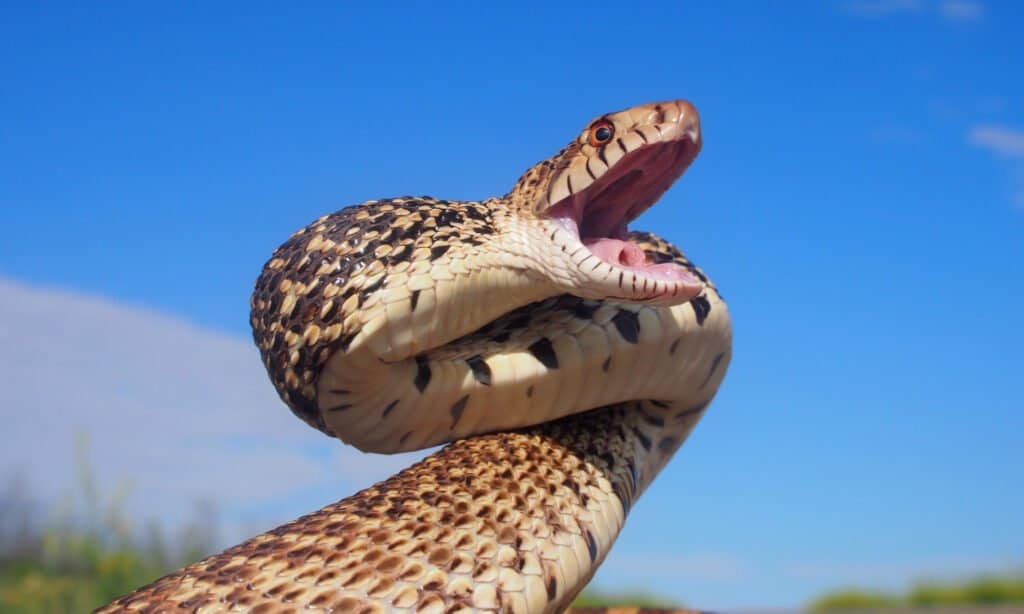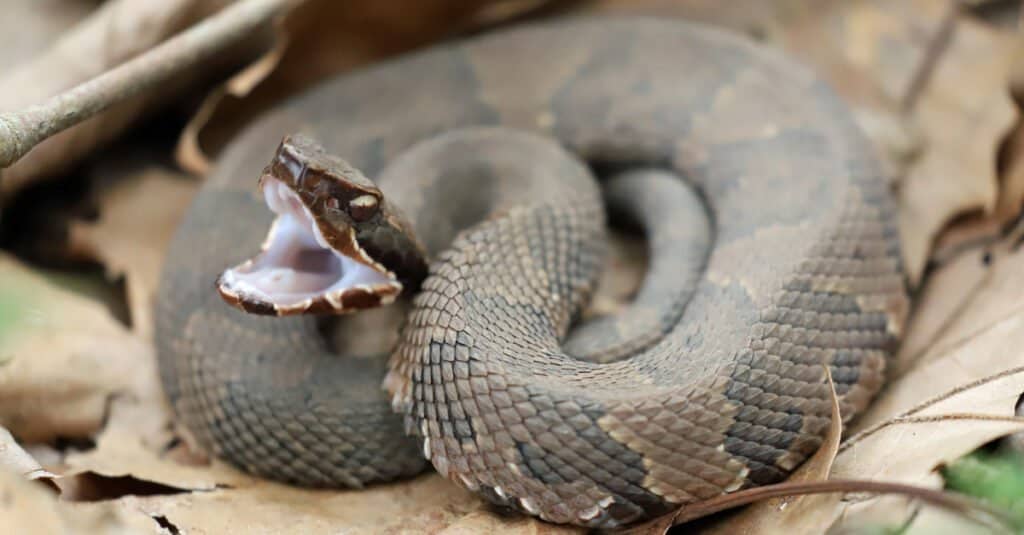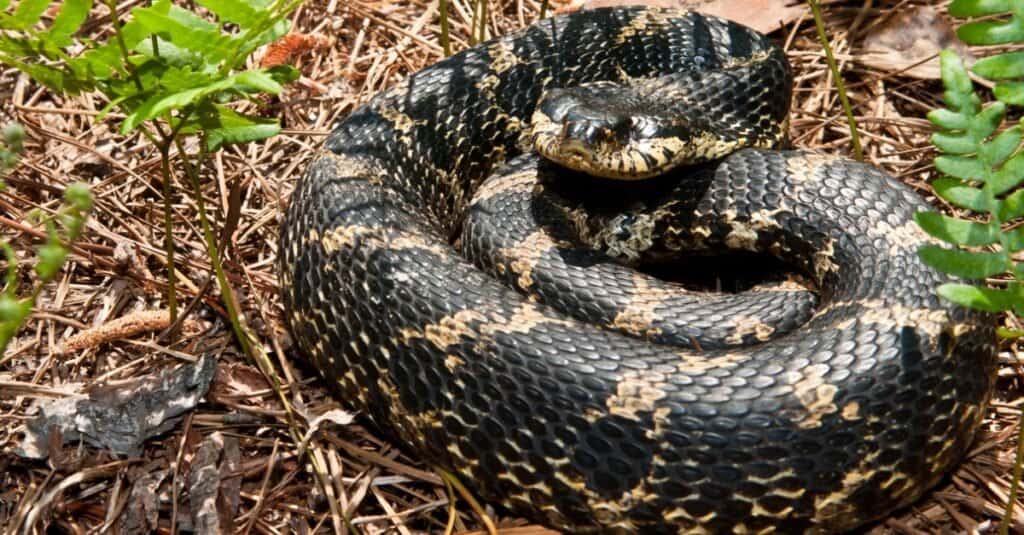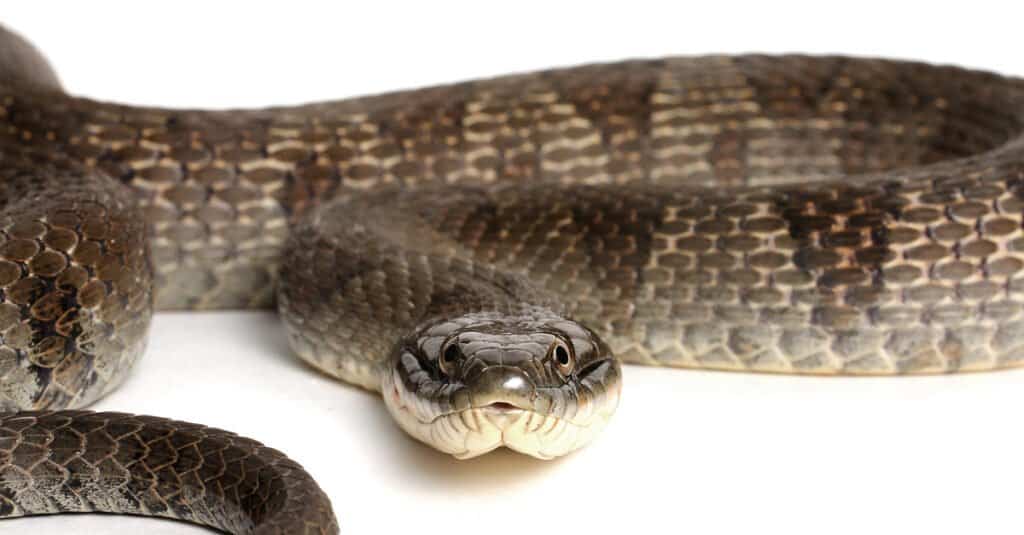8 Snakes That Look Like Rattlesnakes (But Aren’t)
#mobileSnakeQuizControls { overflow: hidden; text-overflow: ellipsis; white-space: nowrap; }
@media (min-width: 481px) {
.mobile-top-content {
display: none;
}
}
#mobileTopContentCTACarouselControls { overflow: hidden; text-overflow: ellipsis; white-space: nowrap; }
.mobile-top-content .more { color: #fff; }
.mobile-top-content a { color: #fff; text-decoration: underline; }
.mobile-top-content a:hover { color: #fff; text-decoration: underline; }
@media (max-width: 480px) {
.mobile-top-content {
background-color: #06a10b;
color: #fff;
text-align: center;
/*height: 60px;
padding-top:5px;*/
font-size:80%;
/* display: block; */
margin: 0px -30px;
}
}
Rattlesnakes have the most deadly venom of any snake in North America. They can be found as far north as southern Canada, and as far south as Argentina. There are many snakes that look like rattlesnakes, but aren’t nearly as deadly. Rattlesnakes possess a hemotoxic venom that they use to rapidly kill and digest their prey. But, fortunately for humans, rattlers would much rather bite a nice mouse or rat than attack a human.
Here, we’ll learn about the eight species of snake most commonly confused with rattlesnakes. Why is it important to know the difference? Well, no matter the type of snake, you should avoid handling it. Remember, all snakes are wild animals, and don’t want to be touched. But, in the case of the rattlesnake, it’s especially important to know whether the snake you’re looking at is, or isn’t, a rattler. Rattlesnake bites can become life threatening if left untreated, whereas the bites of other, non-venomous snakes, are not life threatening.
1. Gopher Snake/Bullsnake

Markparker1983/Shutterstock.com
button.pulse {
transform: scale(1); animation: pulse 2s infinite;
box-shadow: 0 0 0 0 rgba(11, 247, 25, 1);
}
@keyframes pulse {
0% { transform: scale(0.90); box-shadow: 0 0 0 0 rgba(11, 247, 25, 0.5); }
60% { transform: scale(1); box-shadow: 0 0 0 15px rgba(11, 247, 25, 0); }
100% { transform: scale(0.90); box-shadow: 0 0 0 0 rgba(11, 247, 25, 0); }
}
Bullsnakes, also known as gopher snakes, occupy many of the same places as rattlesnakes. At first glance, the two look similar—they both have diamond-shaped patterns running down their bodies. But, bullsnakes are non-venomous, and have actually evolved to look like rattlesnakes so that would-be predators leave them alone.
The best way to tell a bullsnake from a rattler is by looking at the head; rattlesnakes have spade-shaped, triangular heads, whereas bullsnakes have narrow heads that are the same width as their necks. Also, bullsnakes lack a rattle.
2. Eastern Indigo Snake

Patrick K. Campbell/Shutterstock.com
The eastern indigo snake is so named for the beautiful blue-black color of its scales. Only the head is differently colored, with a flush of orange scales on the underside. With such a huge difference in coloring—rattlesnakes are yellow-brown with a repeating diamond pattern—indigo snakes aren’t likely to be mistaken for rattlers on looks alone.
However, eastern indigo snakes have been known to vibrate the tips of their tails as if they had a rattle in an attempt to mimic rattlesnakes. Rest assured though, indigo snakes are non-venomous and do not present a danger to humans.
3. Cottonmouth/Water Moccasin

KF2017/Shutterstock.com
Water moccasins, also known as cottonmouths, are common in the southeastern United States. They’re sometimes confused with rattlesnakes; both are venomous and bites require immediate medical attention. However, cottonmouths are semi-aquatic, whereas rattlesnakes live on dry land.
Cottonmouths don’t have rattles, and they also don’t have the striking diamond pattern markings of rattlesnakes. Cottonmouth coloring varies, but they’re typically duller than rattlesnakes, and smaller.
4. Eastern Copperhead

Jeff W. Jarrett/Shutterstock.com
Copperheads, as eastern copperhead snakes are commonly called, are found throughout the eastern United States. Like rattlers, they’re members of the pit viper family and can sense heat. They’re venomous, and occasionally bite humans, but they’re not rattlesnakes. Copperheads are also often confused with corn snakes, eastern milk snakes, and eastern ratsnakes.
Rattlesnakes, of course, have rattles, whereas copperheads do not. Copperheads have hourglass-shaped markings, while rattlesnakes often have diamond-like patterning. Rattlesnakes tend to be yellow to brown in color, while copperheads are closer to orange. Further, copperheads lack the distinct spade-shaped head of the rattlesnake.
5. Eastern Hognose Snake

Hognose snakes, also known as puff adders, are native to the eastern half of the United States. They can be found as far south as Florida, and as far north as Canada. When threatened, they actually flatten their necks and open their mouths wide to make themselves look bigger. Rattlesnakes, on the other hand, do not flatten their bodies, instead choosing to rattle their infamous rattles to ward off attackers.
Eastern hognose snakes range in color from yellow and brown with rattlesnake-like markings, to pure black. Perhaps the easiest way to differentiate them from rattlers is by the head—it’s narrow, with a pointed, hog-like snout.
6. Northern Water Snake

Michiel de Wit/Shutterstock.com
One of the more common snakes in the eastern United States is the northern water snake. These snakes grow up to five feet in length and spend their lives in riparian environments. These include rivers, lakes, ponds, and swampy areas. Unlike rattlesnakes, northern water snakes are aquatic, and spend most of their time hunting for frogs, salamanders, and toads. Northern water snakes look like rattlesnakes, with a few key differences.
The easiest way to tell the difference between a rattlesnake and a northern water snake is by the presence of a rattle. After that, the shape of the head is the next biggest indication. Northern water snakes have heads that are no wider than their necks, while rattlesnakes have distinct, triangular heads.
7. Eastern Milk Snake

iStock.com/mynewturtle
Of all the snakes confused with rattlesnakes, the eastern milk snake may just be the most innocuous. Eastern milk snakes prey on small creatures like mice and shrews, and they like to stay hidden from humans. Unlike rattlers, who can grow up to eight feet in length, eastern milk snakes rarely exceed three feet.
Eastern milk snakes aren’t venomous, and they don’t have rattles. Further, they don’t have the characteristic leaf-shaped heads of rattlesnakes. Their coloring ranges from tan and orange to yellow and brown; they’re often much more vibrant than rattlesnakes. Eastern milk snakes aren’t just smaller, and less dangerous than rattlers, they’re also gentler, and very unlikely to bite.
8. Eastern Rat Snake

Mike Wilhelm/Shutterstock.com
The eastern rat snake used to be called the black rat snake, a misleading name. Rat snakes actually come in black, yellow, and patterned variations. They can grow up to eight feet long and live across the eastern United States. Like many species of snake, they’re non-venomous and strictly eat small mammals, reptiles, amphibians, and eggs.
People occasionally mistake rat snakes for rattlesnakes, though there are a few easy ways to tell the difference between the two. First, rat snakes have no rattle, nor do they have diamond markings. Further, rat snakes have narrow heads, and lack the heat-sensing pits in front of their eyes that rattlesnakes have. Rat snakes might grow to large sizes, but they present no threat to humans or pets.
Up Next…
Keep reading! We think you’ll like these other pages about snakes and other amazing animals.
- New Study: Giant, Flying Spiders to Invade North Toward D.C. and New York
- Cottonmouth Vs Timber Rattlesnake: 5 Key Differences
- Northern Watersnake Vs Cottonmouth
- Kingsnake Vs Cottonmouth: What are the Differences & Which is More Dangerous?
- Ball Python Morphs: Discover The 50+ Types Of Ball Python Breeds
- Black Racer Snake Vs Cottonmouth
Discover the “Monster” Snake 5X Bigger than an Anaconda
Every day A-Z Animals sends out some of the most incredible facts in the world from our free newsletter. Want to discover the 10 most beautiful snakes in the world, a “snake island” where you’re never more than 3 feet from danger, or a “monster” snake 5X larger than an anaconda? Then sign up right now and you’ll start receiving our daily newsletter absolutely free.
More from A-Z Animals
.more-snake-card-image { max-height:140px !important; }
#mobileSnakeQuizControls { overflow: hidden; text-overflow: ellipsis; white-space: nowrap; }
@media (min-width: 481px) {
.mobile-top-content {
display: none;
}
}
#mobileTopContentCTACarouselControls { overflow: hidden; text-overflow: ellipsis; white-space: nowrap; }
.mobile-top-content .more { color: #fff; }
.mobile-top-content a { color: #fff; text-decoration: underline; }
.mobile-top-content a:hover { color: #fff; text-decoration: underline; }
@media (max-width: 480px) {
.mobile-top-content {
background-color: #06a10b;
color: #fff;
text-align: center;
/*height: 60px;
padding-top:5px;*/
font-size:80%;
/* display: block; */
margin: 0px -30px;
}
}
Rattlesnakes have the most deadly venom of any snake in North America. They can be found as far north as southern Canada, and as far south as Argentina. There are many snakes that look like rattlesnakes, but aren’t nearly as deadly. Rattlesnakes possess a hemotoxic venom that they use to rapidly kill and digest their prey. But, fortunately for humans, rattlers would much rather bite a nice mouse or rat than attack a human.
Here, we’ll learn about the eight species of snake most commonly confused with rattlesnakes. Why is it important to know the difference? Well, no matter the type of snake, you should avoid handling it. Remember, all snakes are wild animals, and don’t want to be touched. But, in the case of the rattlesnake, it’s especially important to know whether the snake you’re looking at is, or isn’t, a rattler. Rattlesnake bites can become life threatening if left untreated, whereas the bites of other, non-venomous snakes, are not life threatening.
1. Gopher Snake/Bullsnake

Markparker1983/Shutterstock.com
button.pulse {
transform: scale(1); animation: pulse 2s infinite;
box-shadow: 0 0 0 0 rgba(11, 247, 25, 1);
}
@keyframes pulse {
0% { transform: scale(0.90); box-shadow: 0 0 0 0 rgba(11, 247, 25, 0.5); }
60% { transform: scale(1); box-shadow: 0 0 0 15px rgba(11, 247, 25, 0); }
100% { transform: scale(0.90); box-shadow: 0 0 0 0 rgba(11, 247, 25, 0); }
}
Bullsnakes, also known as gopher snakes, occupy many of the same places as rattlesnakes. At first glance, the two look similar—they both have diamond-shaped patterns running down their bodies. But, bullsnakes are non-venomous, and have actually evolved to look like rattlesnakes so that would-be predators leave them alone.
The best way to tell a bullsnake from a rattler is by looking at the head; rattlesnakes have spade-shaped, triangular heads, whereas bullsnakes have narrow heads that are the same width as their necks. Also, bullsnakes lack a rattle.
2. Eastern Indigo Snake

Patrick K. Campbell/Shutterstock.com
The eastern indigo snake is so named for the beautiful blue-black color of its scales. Only the head is differently colored, with a flush of orange scales on the underside. With such a huge difference in coloring—rattlesnakes are yellow-brown with a repeating diamond pattern—indigo snakes aren’t likely to be mistaken for rattlers on looks alone.
However, eastern indigo snakes have been known to vibrate the tips of their tails as if they had a rattle in an attempt to mimic rattlesnakes. Rest assured though, indigo snakes are non-venomous and do not present a danger to humans.
3. Cottonmouth/Water Moccasin

KF2017/Shutterstock.com
Water moccasins, also known as cottonmouths, are common in the southeastern United States. They’re sometimes confused with rattlesnakes; both are venomous and bites require immediate medical attention. However, cottonmouths are semi-aquatic, whereas rattlesnakes live on dry land.
Cottonmouths don’t have rattles, and they also don’t have the striking diamond pattern markings of rattlesnakes. Cottonmouth coloring varies, but they’re typically duller than rattlesnakes, and smaller.
4. Eastern Copperhead

Jeff W. Jarrett/Shutterstock.com
Copperheads, as eastern copperhead snakes are commonly called, are found throughout the eastern United States. Like rattlers, they’re members of the pit viper family and can sense heat. They’re venomous, and occasionally bite humans, but they’re not rattlesnakes. Copperheads are also often confused with corn snakes, eastern milk snakes, and eastern ratsnakes.
Rattlesnakes, of course, have rattles, whereas copperheads do not. Copperheads have hourglass-shaped markings, while rattlesnakes often have diamond-like patterning. Rattlesnakes tend to be yellow to brown in color, while copperheads are closer to orange. Further, copperheads lack the distinct spade-shaped head of the rattlesnake.
5. Eastern Hognose Snake

Hognose snakes, also known as puff adders, are native to the eastern half of the United States. They can be found as far south as Florida, and as far north as Canada. When threatened, they actually flatten their necks and open their mouths wide to make themselves look bigger. Rattlesnakes, on the other hand, do not flatten their bodies, instead choosing to rattle their infamous rattles to ward off attackers.
Eastern hognose snakes range in color from yellow and brown with rattlesnake-like markings, to pure black. Perhaps the easiest way to differentiate them from rattlers is by the head—it’s narrow, with a pointed, hog-like snout.
6. Northern Water Snake

Michiel de Wit/Shutterstock.com
One of the more common snakes in the eastern United States is the northern water snake. These snakes grow up to five feet in length and spend their lives in riparian environments. These include rivers, lakes, ponds, and swampy areas. Unlike rattlesnakes, northern water snakes are aquatic, and spend most of their time hunting for frogs, salamanders, and toads. Northern water snakes look like rattlesnakes, with a few key differences.
The easiest way to tell the difference between a rattlesnake and a northern water snake is by the presence of a rattle. After that, the shape of the head is the next biggest indication. Northern water snakes have heads that are no wider than their necks, while rattlesnakes have distinct, triangular heads.
7. Eastern Milk Snake

iStock.com/mynewturtle
Of all the snakes confused with rattlesnakes, the eastern milk snake may just be the most innocuous. Eastern milk snakes prey on small creatures like mice and shrews, and they like to stay hidden from humans. Unlike rattlers, who can grow up to eight feet in length, eastern milk snakes rarely exceed three feet.
Eastern milk snakes aren’t venomous, and they don’t have rattles. Further, they don’t have the characteristic leaf-shaped heads of rattlesnakes. Their coloring ranges from tan and orange to yellow and brown; they’re often much more vibrant than rattlesnakes. Eastern milk snakes aren’t just smaller, and less dangerous than rattlers, they’re also gentler, and very unlikely to bite.
8. Eastern Rat Snake

Mike Wilhelm/Shutterstock.com
The eastern rat snake used to be called the black rat snake, a misleading name. Rat snakes actually come in black, yellow, and patterned variations. They can grow up to eight feet long and live across the eastern United States. Like many species of snake, they’re non-venomous and strictly eat small mammals, reptiles, amphibians, and eggs.
People occasionally mistake rat snakes for rattlesnakes, though there are a few easy ways to tell the difference between the two. First, rat snakes have no rattle, nor do they have diamond markings. Further, rat snakes have narrow heads, and lack the heat-sensing pits in front of their eyes that rattlesnakes have. Rat snakes might grow to large sizes, but they present no threat to humans or pets.
Up Next…
Keep reading! We think you’ll like these other pages about snakes and other amazing animals.
- New Study: Giant, Flying Spiders to Invade North Toward D.C. and New York
- Cottonmouth Vs Timber Rattlesnake: 5 Key Differences
- Northern Watersnake Vs Cottonmouth
- Kingsnake Vs Cottonmouth: What are the Differences & Which is More Dangerous?
- Ball Python Morphs: Discover The 50+ Types Of Ball Python Breeds
- Black Racer Snake Vs Cottonmouth
Discover the “Monster” Snake 5X Bigger than an Anaconda
Every day A-Z Animals sends out some of the most incredible facts in the world from our free newsletter. Want to discover the 10 most beautiful snakes in the world, a “snake island” where you’re never more than 3 feet from danger, or a “monster” snake 5X larger than an anaconda? Then sign up right now and you’ll start receiving our daily newsletter absolutely free.







